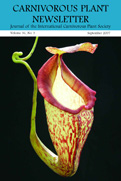International Carnivorous Plant Society
Carnivorous Plant Newsletter Archive
What is the evidence for medicinal value of carnivorous plants?
Chan, Michael M. and Mallory M. Chan and Edward D. Chan
Carniv. Pl. Newslett. 36(3):83-86
Published 22 September 2007
https://doi.org/10.55360/cpn363.mc939
Summary
Throughout history, plants have been used for medicinal purposes. Many of the modern allopathic medicines used today are either directly or indirectly derived from plants. Examples include the cardiotonic and antiarrhythmic agent digoxin (derived from the foxglove—Digitalis purpurea), antimalarial quinine (derived from the bark of the cinchona tree—Cinchona officinalis), the mydriatic (pupil dilatory) agent belladonna (derived from the nightshade Atropa belladonna), aspirin (derived from the bark of the willow tree—Salix alba, etc.), taxol (derived from the yew tree—Taxus brevifolia) and vincristine (derived from the periwinkle—Catharanthus roseus (=Vinca rosea)). Although carnivorous plants have been used medicinally, to date not a single compound derived from carnivorous plants has been widely-accepted in modern allopathic medicine. Pinguicula spp., Dionaea muscipula, Drosera spp., Sarracenia purpurea, and Nepenthes spp. are the carnivorous plants frequently touted as having therapeutic potential. We herein review the existing literature on the medical uses of these plants.
Keywords: practical uses: Dionaea muscipula, Drosera, Nepenthes khasiana, Pinguicula, Sarracenia purpurea
Article Citation
Chan, Michael M. and Mallory M. Chan and Edward D. Chan. 2007. What is the evidence for medicinal value of carnivorous plants?. Carniv. Pl. Newslett. 36(3):83-86. https://doi.org/10.55360/cpn363.mc939
Page views: 1079
©2025 International Carnivorous Plant Society
www.carnivorousplants.org
This page is maintained by John Brittnacher.
Please contact us at our membership website, icps.clubexpress.com.
Privacy: The Carnivorous Plant Newsletter Archive website does not track users.

